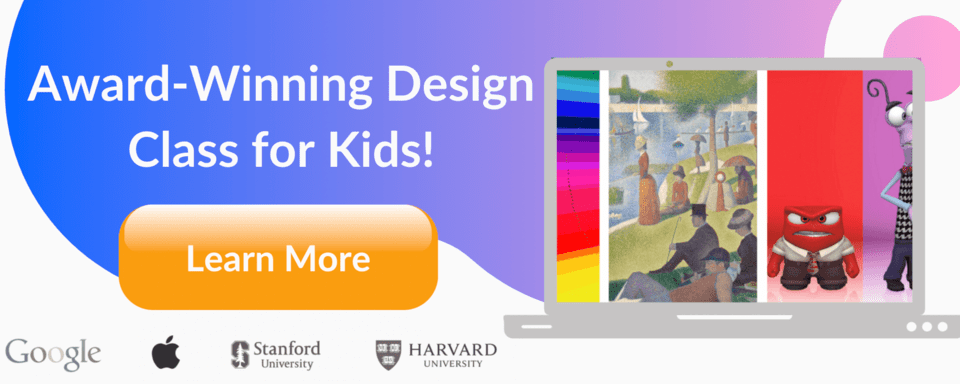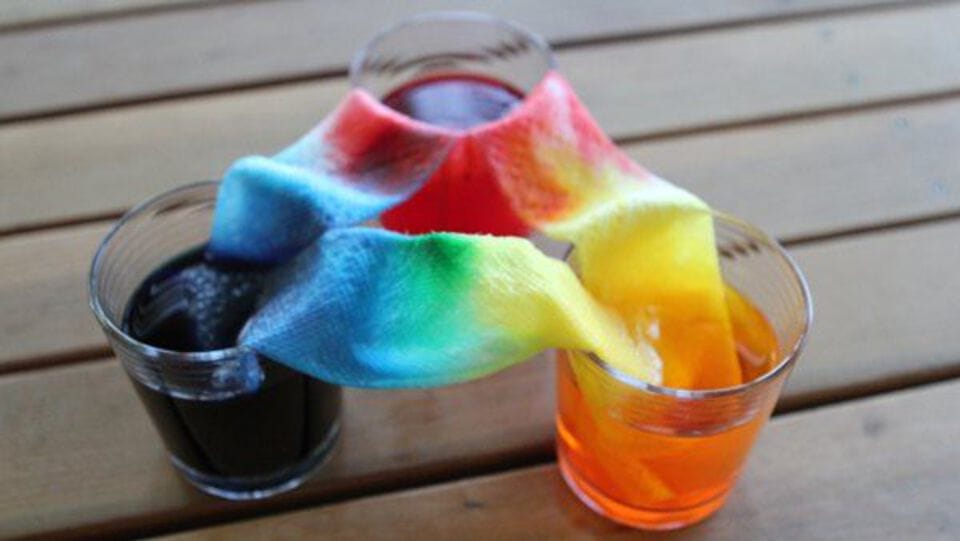Not many people realize it, but learning color theory for kids can really enhance their eye for design. Color theory is a skill that can be carried for the rest of one’s design career.
In this article, color theory is explained, and we explore why it is a valuable skill to learn. We will also look at different digital design classes, resources, and projects kids can do all on their own with no money spent!
This is perfect for a new hobby to learn at home, or for someone who wants to expand their knowledge in all things design and art related. Keep reading if the subject of color theory sounds like it might be a great fit for you. Or jump right into a fun online Thanksgiving drawing class and a free make a digital holiday card event.

Explore color theory for kids
As you continue to read on, you will learn about several different factors that play a part in the theory of color. Color is important in our world, because colors are more than just pretty things to look at in art.
Color allows us to feel certain emotions - sometimes without us even noticing! Warm colors can make us feel happy and excited while cold colors can make us feel sad or reserved.
Colors also tell us stories without any words even being said. Among many different factors, we will touch base on the color wheel, primary and tertiary colors, and why all of this is important in design, art, computer science, and just life in general!
Learn the color wheel
Have you ever seen a color wheel before? Even if you answered no, most likely you have! Ever since we were super young, the color wheel has been taught to us in school, art classes, and informative television shows and books. It might just look like a rainbow in a circle, but this wheel holds so much knowledge that can benefit any and every creative!

A color wheel makes it easy for us to identify which colors are primary, secondary, and tertiary. By knowing this information, it is simple to find the perfect color combinations for whatever project we are working on. From designing a dress to figuring out what colors look good for a painting you have yet to make, having a color wheel easily accessible lets us know which colors can be the best fit.
Primary colors
Primary colors are essential in knowing the theory of color. What are primary colors exactly? There are three specific colors that we can mix together to make a huge range of many different colors. Those three colors are red, yellow, and blue. Without these three colors, every other color we know would not exist either. Don’t believe me? Try getting your red, blue, and yellow colored pencils and coloring over each other. Or try getting your paint and mixing them together. Do you notice the changes that occur as a result of combining these primary colors together?
Secondary colors
Secondary colors are the colors we have as a result of mixing two primary colors together. For example, when we combine blue with yellow, we get the color green. Green is a secondary color! Think of these colors like the baby colors and red, blue, and yellow are our parent colors. How many secondary colors do you think you can create?
If you said three, you are correct! Green, orange, and purple are the three secondary colors we can find on the color wheel. They might not be primary colors, but they are just as important to our society. Composting bins, street cones, and Yahoo! are created by secondary colors. Imagine if our world didn’t have secondary colors!
Tertiary colors
We learned about our primary and secondary colors, so it is only right that we talk about tertiary colors as well! It is a bit difficult to pronounce, but tertiary colors are not hard to learn about at all. Tertiary colors are what we get when we combine a primary color with a secondary color. In total, there are six tertiary colors: red-orange, yellow-orange, yellow-green, blue-green, blue-violet, and red-violet.
Having tertiary colors is great, because different shades and tones of colors can express a completely different emotion and message. Compare the color green to the mixture color of yellow-green. Dark green can symbolize prestige and royalty while yellow-green showcases a more serene and playful feeling. Tertiary colors are just as important to our world as both primary and secondary!
Color theory printables and resources
Now that you know a little bit more about the colors, here are a few resources that can print out at home!
- Primary, secondary, and tertiary color wheels: Check out this page to have the different color wheels already filled out and easily accessible for any project!
- Color wheel and color blending worksheets: These empty worksheets are great practice to see how certain colors make an even wider range of colors!
- Detailed explanations about the vocabulary terms we just discussed, plus more terms such as analogous, triadic, and tetradic colors: This website also offers a virtual color wheel in which you can pick a color and the site provides a color combination for you.
Color theory project ideas
1. Color Mixing Experiment:
If you have cups you can fill with water, paper towels, and food coloring in our primary colors: red, blue, and yellow, then congrats! You can do this fun color theory experiment from the comfort of your own home!
In each cup of water, add 30 drops of food coloring. Each cup should have its own color. One cup of yellow water, one cup of blue water, and one of red. Then, get three pieces of paper towel. For each cup, place a paper towel that is folded in half vertically. Half of the paper towel should be submerged in the dyed water, and the other half should be sticking out of the cup. The end that is not in water, place it in another cup’s dye.
Place the first end of one paper towel in the blue cup. And the second end in the yellow cup. Put the first end of the next paper towel in the yellow cup and the second end in the red cup. Finally, place the first end of the last paper towel in the red cup and the second end in the blue cup.
You will start to see the colors travel through the paper towels as it absorbs the water. Since we used primary colors and they are getting blended together, the paper towels will start to show secondary colors right before your eyes!

2. Colorful Stamps
Do you have a dream vacation? Or maybe you already travelled and want to visit again soon? With a pencil and paper, sketch a stamp for your destination. For example, if you loved a trip to Disneyland, draw a stamp of the decorations all around the theme park! Draw this stamp three times on the same sheet of paper. Make sure there is space in between each!
After drawing your stamp three times, try challenging yourself. With either paint or crayons/colored pencils, color each stamp using a different color palette. In our Disneyland example, you could color the first stamp as if it is in the morning, color the second stamp as the sun is setting, and for the last stamp you can color the sky as if it is night time and the fireworks have been set. Try having fun and being creative for these three different color palettes!
3. Characters of The Rainbow
What is your favorite show? Favorite video game? Whether you love cars, pokemon, or crystals, try seeing if you can match them with a specific color! By printing out an empty color wheel or by drawing your own with pencil and paper, you can draw each figure within the color wheel with their matching color.
For example, for your yellow section in my color wheel, you can draw Pikachu. For blue, you can draw Gyarados. Keep going until every section of your color wheel has a character. Then, color it all in! You can use colored pencils, crayons, or markers. After both the characters and the color wheel is colored in completely, you now have an amazing poster you can hang up on your wall!

Get started with color theory for kids
As you can see, color is very important in not only the world of art and design, but it adds meaning to even the most mundane aspects of life. Without color, life would not make as much sense as it does now. From fashion and media, to websites and logos, to even street lights and signage, color is all around us! When kids learn the theory of color early, their creativity will be endless and they will continue to grow as an artist and designer.
If reading this post made you fall in love with color even more, or if you want a more interactive approach to learning about color theory, Create & Learn offers a power of color class packed with so many fun activities and exercises. Get started with fun digital design classes for kids or read more about the best online art classes.

Written by Marielle Cruz Cabillo, a Create & Learn instructor who has a BS in Visual Communication Design with a Minor in Marketing, and has taught children for 6 years.




